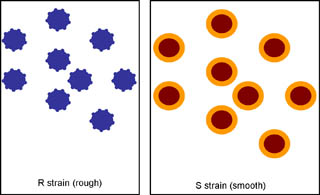Streptococcus pneumoniae was an important research topic in the 1920’s for several reasons. Not only could pneumonia could be treated or cured, but scientists could learn which molecule in the human body contains DNA through the research. The smooth strain of the disease contains a coating that protects the bacteria long enough to cause the disease, while the rough strain does not have that feature.
Through a lab performed on four mice, each one has been injected with a strain of the bacteria, a rough strain, a smooth strain, a heat-killed smooth strain, and a rough strain combined with a heat-killed smooth strain. The rough strain, the control, and the heat-killed smooth strain lived, while the others died. The rough strain with the heat-killed smooth strain is unexpected, since the rough strain and the heat-killed smooth kept the mice alive. One hypothesis could be that one strain makes the other stronger and infect the mouse.
In another experiment, scientists used proteases, DNases, and RNases to treat dead smooth bacteria. The enzymes could repair the broken protein, DNA, or RNA from the bacteria. Since the bacteria damages the genetic material of the cell, the living mouse with the correct repairing enzyme shows where the material is. In the end, the mouse injected with the DNase survived. This showed that genetic coding is found in DNA. We know that as an everyday fact now, but in the 1920’s, it was groundbreaking.
